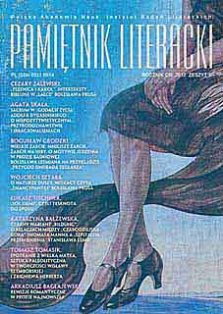Sacrum w „Godach życia” Adolfa Dygasińskiego. O niepozytywistycznym przyrodoznawstwie i irracjonalizmach
The Sacred in Adolf Dygasiński’s “Feasts of Life” (“Gody życia”). On Non-Positivistic Natural History and Irrationalisms
Author(s): Agata SkałaSubject(s): Literary Texts
Published by: Instytut Badań Literackich Polskiej Akademii Nauk
Keywords: Adolf Dygasiński; Dygasiński’s “Feasts of Life;” Dygasiński’s “Oak trees (Dęby);” Dygasiński’s “Wonderful tales (Cudowne bajki);” Dygasiński’s “Extreme (Krańcowy);” Dygasiński’s (Opis imprezy wojennej imć pana Alberta Milicerego)”
Summary/Abstract: Adolf Dygasiński’s literary creativity associated with naturalism transgresses the limits of Positivism. A conventional motif of vain biological circle, the concept of love and suffering close to that of Christians, interest in metaphysics, means of expressions typical of Young Poland’s symbolism and emotional earnestness – all of them make up a token that Dygasiński’s writings break up with the established models. Dygasiński’s most intriguing piece, i.e. “Feasts of Life,” manifests the sacred. The rhythm of vegetation that symbolize the mysteries of cosmic reviving make up the novel’s metaphysical design, the sacral dimension is organized by the structure of Slavonic year’s rituals, whilst moral explanation of “Feasts of Life” is settled by hidden quotations from the “Bible.” A distance from Positivism is also marked in Dygasiński’s other pieces, e.g. “Oak trees (Dęby),” “Wonderful tales (Cudowne bajki),” “Extreme (Krańcowy),” “A Description of Mr. Albert Milicery’s Battle (Opis imprezy wojennej imć pana Alberta Milicerego).”
Journal: Pamiętnik Literacki. Czasopismo kwartalne poświęcone historii i krytyce literatury polskiej
- Issue Year: 2012
- Issue No: 1
- Page Range: 31-45
- Page Count: 15
- Language: Polish

